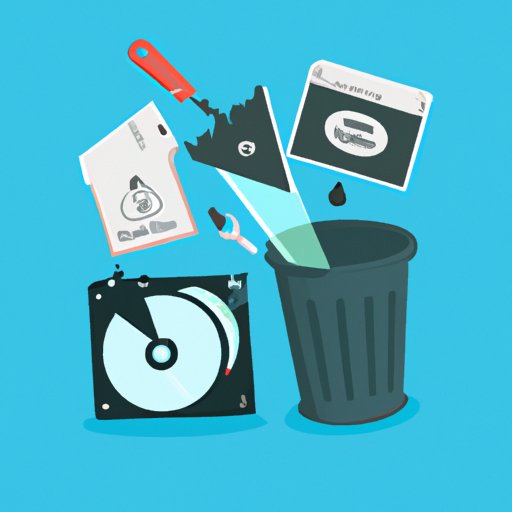I. Introduction
There’s nothing more frustrating than trying to get work done on a computer that’s running out of disk space. Not only can it limit your ability to store files and applications, it can also slow down your computer and make it difficult to work efficiently. The good news is, there are many solutions for freeing up space on your computer’s hard drive. In this article, we’ll provide a comprehensive guide on how to do just that.
II. Uninstalling Unused Programs
The first step to freeing up space on your computer is to uninstall any programs that you’re not using. To do this, you’ll need to first identify which programs are taking up the most space. On Windows, you can do this by going to the Control Panel, clicking on “Programs,” and then selecting “Programs and Features.” On Mac, you can go to the Applications folder and sort by size.
To uninstall a program on Windows, simply select it from the list and click “Uninstall.” On Mac, you can drag the program icon to the trash. When deciding which programs to uninstall, consider whether you really need them and how often you use them. If you haven’t used a program in months, it’s probably safe to delete it.
III. Clearing Temporary Files
Temporary files are files that are created by your operating system and applications to store information temporarily. Over time, these files can accumulate and take up valuable space on your hard drive. Clearing them out can help free up a significant amount of space.
To clear temporary files on Windows, you can use the built-in Disk Cleanup tool. To do this, go to the Start menu and type “Disk Cleanup” in the search bar. Select the drive you want to clean up and click “OK.” The tool will then calculate how much space you can free up and give you the option to delete temporary files.
On Mac, you can clear temporary files by going to the Finder, selecting “Go” in the top menu, and then selecting “Go to Folder.” Type in “/var/folders” and press “Go.” From there, you can delete any folders that are old or no longer needed. You can also use a third-party tool like CleanMyMac to automate the process.
IV. Using Cloud Storage
If you have files that you need to keep but don’t want to store on your hard drive, using a cloud storage service is a great option. Popular services like Google Drive, Dropbox, and iCloud allow you to store files in the cloud and access them from any device with an internet connection.
When deciding which files to store in the cloud, consider which ones you access frequently and which ones can be safely removed from your hard drive. Documents, photos, and music are all good candidates for storage in the cloud.
V. Moving Files to an External Hard Drive
If you have a large number of files that you want to keep but don’t necessarily need access to all the time, moving them to an external hard drive is a good option. This can free up a significant amount of space on your hard drive.
To do this on Windows, you can simply plug in your external hard drive and drag and drop files from your hard drive to the external drive. On Mac, you can use the built-in Time Machine feature to back up your files to an external drive.
VI. Deleting Old or Unnecessary Files
Regularly reviewing and deleting old files is an important part of keeping your hard drive free of clutter. This can be done manually by going through your files and deleting anything that you no longer need. You can also use strategies like creating folders and using file naming conventions to help keep your files organized and easier to manage.
VII. Cleaning Up the Desktop
If your desktop is cluttered with files and shortcuts, it can slow down your computer and make it difficult to find what you need. To clean up your desktop, create folders for different types of files and move them off the desktop. You can also use a desktop organizer tool like Fences on Windows or Desktop Groups on Mac to keep your desktop tidy.
VIII. Using Disk Cleanup Tools
Both Windows and Mac have built-in tools that can help you free up space on your hard drive. On Windows, the Disk Cleanup tool can be used to clear out temporary files and other unnecessary files. On Mac, the Storage Management tool can be used to identify which files are taking up the most space and help you remove them.
When using these tools, be sure to read the prompts carefully and make sure that you’re only deleting files that you no longer need.
IX. Conclusion
By following the solutions discussed in this article, you can free up space on your computer’s hard drive and improve its performance. Regularly uninstalling unused programs, clearing temporary files, using cloud storage and external hard drives, deleting old or unnecessary files, and cleaning up the desktop are all effective strategies for keeping your computer running smoothly.
